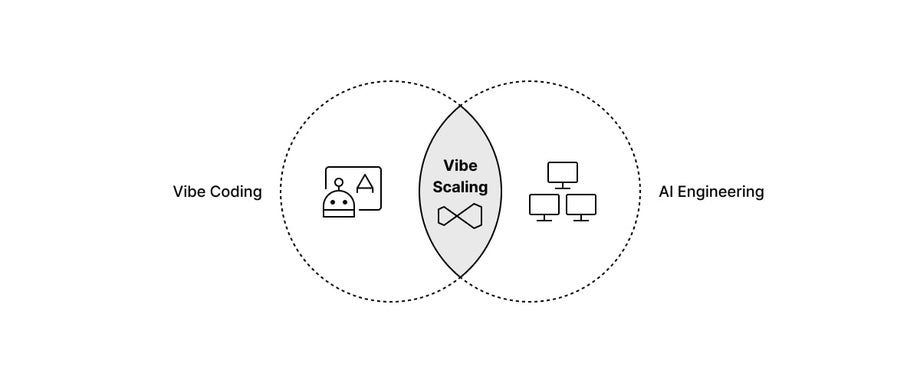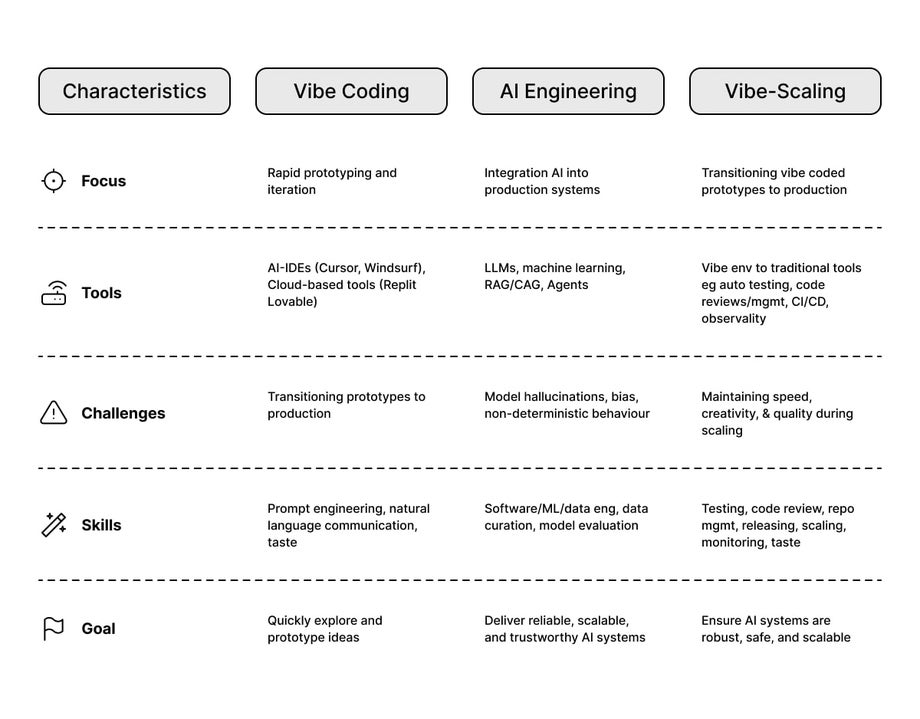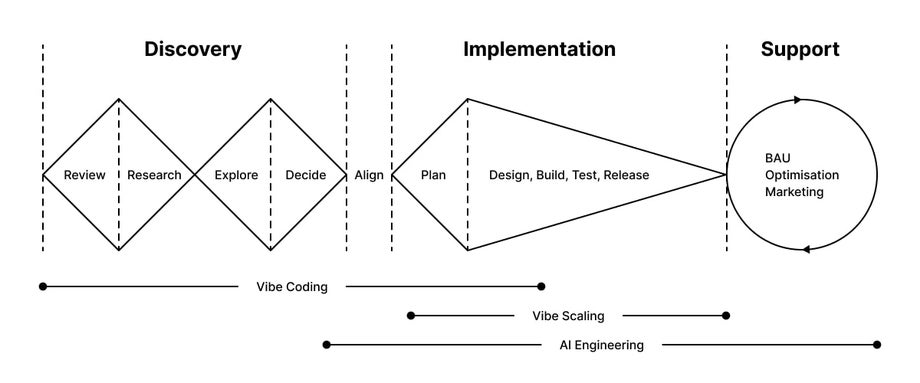

25.07.20226 mins read
In just two years, the world of software development has been transformed by AI, particularly large language model (LLM) powered tools, the latest step in a decades-long trend of lowering the barrier between human intent and computer execution. Every time this barrier previously dropped from assembly coding to high-level languages to the web and mobile, programming has expanded rather than disappeared.
The same will happen with AI.
Advanced teams are moving beyond simple prompt or copilot auto-complete experiments to embrace powerful, deeply integrated AI workflows reshaping every stage of the build process. And AI engineering practices are reshaping the products and solutions we're building with AI-powered product features (LLMs, ML models, agents).
This presents us with a huge opportunity.
If we harness these AI capabilities to fundamentally transform how we build software, we can deliver more incredible products and experiences and accelerate our roadmaps while unlocking business value faster.

First of all, what is vibe coding? It is software development based on intuition, creativity, and quick iteration instead of rigid, step-driven workflows to bring your ideas to life.
And we cannot underestimate its profound impact on the typical early ideation, prototyping / MVP, planning, and shaping phases.
Live working prototypes (and not just one version but many parallel concepts) are replacing wireframes, static designs, and long product requirement documents (PRDs). These AI-powered critical early stages can increase project velocity, generate more variety in ideas, and improve overall quality due to fewer requirements hand-offs and reduced misunderstandings. Plus, teams are more nimble. We're seeing a blending of capabilities across designers, product/project managers, BAs, and engineers, which drives efficiency and speed.
For simplicity, we're including AI-powered IDEs (e.g. Cursor, Copilot, Windsurf), cloud-based text-to-app environments / AI coding agents (e.g. Lovable, Replit, V0) in our vibe coding definition.
But even here, the boundaries between vibe coding tools built for engineers versus those built for non-techies are also starting to fade, signaling a fundamental shift in how we build software.
We’ve coined the term Vibe-Scaling to describe the bridge between fast, creative vibe coding and robust, production-ready delivery that will unlock new levels of speed, quality, and innovation around roadmaps. Yes, the latest generation of AI-powered IDEs, QA tools, code review agents, engineering intelligence systems, and LLM guardrails are incredibly important for building momentum towards production-ready products & experiences. Still, we cannot forget traditional engineering, quality, DevOps, SecDevOps, observability practices, and many others. The trick is blending both worlds and layering in the organisation and governance to empower teams to deliver faster and with greater confidence using the new generation of AI-powered tooling.
AI engineering focuses on incorporating AI-powered features and capabilities into products and experiences. It includes designing, developing, testing, deploying, scaling, and maintaining features using LLMs, Machine Learning (ML) models, retrieval augmented generation (RAG), and AI Agents at production scale.
However, unlike traditional software engineering, AI engineering must grapple with unique challenges, including model hallucinations, data bias, prompt and output guardrails, non-deterministic behaviour, and the need for continuous monitoring and retraining.
AI engineers will blend established software engineering principles with AI-specific practices like data curation, model evaluation, prompt engineering, and ethical risk mitigation. The goal is to deliver reliable, scalable, and trustworthy AI systems that can be safely integrated into critical business workflows while also adapting to the rapid pace of innovation in the AI field.
As organisations increasingly rely on AI to power core features, AI engineering is essential for ensuring these systems are robust, maintainable, and aligned with organisational goals and compliance requirements.

To take full advantage and increase roadmap velocity in this new AI era requires a new approach to turn fast, AI-driven prototypes (vibe coding) into reliable, production-ready software.
It also requires the evolution of software build approaches to incorporate AI engineering capabilities.
Combining the tools and technologies of AI engineering and vibe coding with the ideas and approaches behind vibe-scaling will be an incredibly powerful way to conceptualise and build amazing new experiences - to unlock business value faster.
Underpinning all of these, needs at a minimum:
- The critical elements of automated & AI testing at every level (but particularly around data & APIs),
- AI guardrails/evaluations (to counteract non-deterministic behaviour),
- AI-powered code reviews of both human and AI-created software (for team efficiency and quality),
- Automated deployments (CI/CD) for faster feedback loops,
- Observability/telemetry for faster feedback/diagnostics and to meet production standards (SLOs) without losing development speed or creativity.
Observability, testing, and guardrails apply to pre-production and also post-production environments because of the non-deterministic behaviour of users, data, models, and AI agents in the real world.
Rapid evolution alert:
The rapid evolution happening daily across the AI ecosystem means teams need an adaptive approach addressing classic engineering needs and AI-specific issues, ensuring AI features and vibe coded systems are robust, safe, and scalable for enterprise and customer use.

Our typical end-to-end process, and where AI-powered capabilities are helping us reshape the process and accelerate roadmap implementation.



